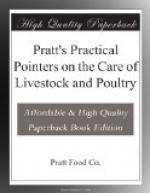RATION FOR GROWING HOGS
Winter wheat middlings 50 lbs. Wheat bran 50 lbs. Corn chop 50 lbs. Whole oats 10 lbs. 50 per cent. Digester tankage 20 lbs.
Soft coal and salt are kept before the herd at all times. The hogs eat these at will.
The grazing system is used on this farm. Many different forage crops are planted, in order to insure a regular succession of succulent feeds. As each field reaches proper condition for grazing, a hog fence is thrown around it and the herd admitted. The hogs do all the work of harvesting, thus securing valuable exercise and at the same time saving man labor. Under this system the fields have steadily improved in fertility, due to the turning under of the uneaten green stuff and the direct application of the valuable hog manure.
Forage crops vary in different sections of the country. On the farm in question the earliest forage is rye, followed in rotation by the various clovers and mixtures of oats, Canada field peas, vetch, soy beans, etc. Dwarf Essex rape is a favorite crop and one that furnishes a tremendous amount of forage per acre.
When the corn crop matures, the larger individuals are given the liberty of the corn fields and the crop is “hogged down.” This again saves a great amount of hand labor, a big item under existing conditions.
In the winter, when grazing is out of the question, the herd receives once daily a liberal feed of second crop alfalfa or clover hay.
Understand, the feeders containing the dry mixture of ground grains, are available to the hogs at all times. They help themselves at will, day and night.
-------------------------------------------------------
---------- La Fontaine, Ind.
We have been trying to produce the largest hog in the world and we have done it! We have a Big Type Poland China hog, that has been fed 123 days, making a gain of 450 pounds and at this time weighs over 1200 pounds. We fed him on Pratts Animal Regulator.
H.E. HENRY. ------------------------------------------------------------
-----
When keeping hogs in large herds like this, it is of primary importance that the most careful attention be paid to sanitation. Pratts Dip and Disinfectant should be used regularly and thoroughly to protect against disease germs and vermin. And Pratts Hog Tonic used to keep the hogs in perfect condition inside.
If sickness appears in the herd the unaffected hogs should at once be removed to clean, disinfected quarters, preferably without much range, for by running over pastures they may come in contact with contagion. Their feed should be carefully regulated, and, if they have previously been on pasture, should include some green feed, roots, or an abundance of skim milk.




